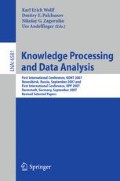Abstract
Rough Sets were introduced to express approximations based on an indiscernibility equivalence relation (Pawlak [4,5]). They have a natural lattice structure, which can nicely be described and widely generalised in the language of Formal Concept Analysis [2]. One instance of such a generalisation seems to be particularly promising: That of an indiscernibility preorder. The mathematical theory is almost the same as in the case of an equivalence relation, and some of the applications can be carried over. However, using preorders as indiscenibility relations needs getting used to, since such relations are not necessarily symmetric. We give an introduction and clarify the role of isolated and singleton elements.
Access this chapter
Tax calculation will be finalised at checkout
Purchases are for personal use only
Preview
Unable to display preview. Download preview PDF.
References
Baixeries, J.: A Formal Concept Analysis Framework To Model Functional Dependencies. In: Proceedings of Mathematical Methods for Learning (2004)
Ganter, B.: Lattices of Rough Set Abstractions as P-Products. In: Medina, R., Obiedkov, S. (eds.) ICFCA 2008. LNCS (LNAI), vol. 4933, pp. 199–216. Springer, Heidelberg (2008)
Ganter, B., Kuznetsov, S.: Scale Coarsening as Feature Selection. In: Medina, R., Obiedkov, S. (eds.) ICFCA 2008. LNCS (LNAI), vol. 4933, pp. 217–228. Springer, Heidelberg (2008)
Pawlak, Z.: Rough Sets. International Journal of Computer and Information Sciences 11, 341–356 (1982)
Pawlak, Z.: Rough Sets: Theoretical Aspects of Reasoning About Data. Kluwer Academic Publishing, Dordrecht (1991)
Wolff, K.E.: Concepts in Fuzzy Scaling Theory: Order and Granularity. Fuzzy Sets and Systems 132(1) (2002)
Zadeh, L.: The concept of a linguistic variable and its applications to approximate reasoning. Parts I–III, Information Sciences 8 (1975), 9 (1976)
See for an extensive bibliography, http://roughsets.home.pl/
Author information
Authors and Affiliations
Editor information
Editors and Affiliations
Rights and permissions
Copyright information
© 2011 Springer-Verlag Berlin Heidelberg
About this paper
Cite this paper
Ganter, B. (2011). Non-symmetric Indiscernibility. In: Wolff, K.E., Palchunov, D.E., Zagoruiko, N.G., Andelfinger, U. (eds) Knowledge Processing and Data Analysis. KPP KONT 2007 2007. Lecture Notes in Computer Science(), vol 6581. Springer, Berlin, Heidelberg. https://doi.org/10.1007/978-3-642-22140-8_2
Download citation
DOI: https://doi.org/10.1007/978-3-642-22140-8_2
Publisher Name: Springer, Berlin, Heidelberg
Print ISBN: 978-3-642-22139-2
Online ISBN: 978-3-642-22140-8
eBook Packages: Computer ScienceComputer Science (R0)

